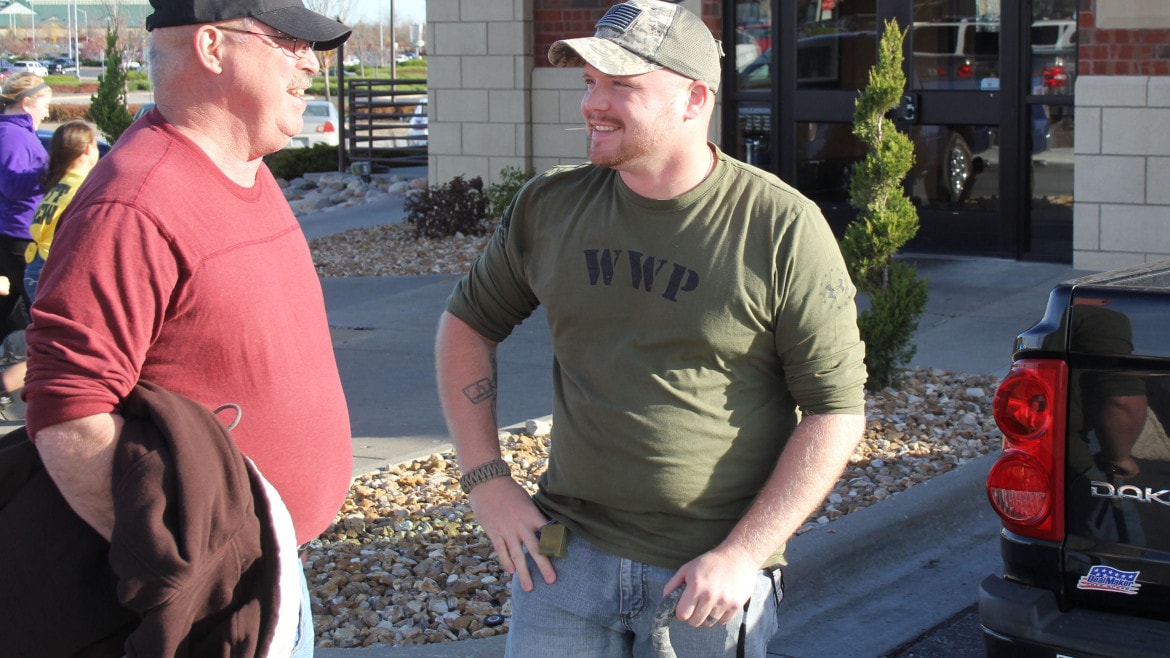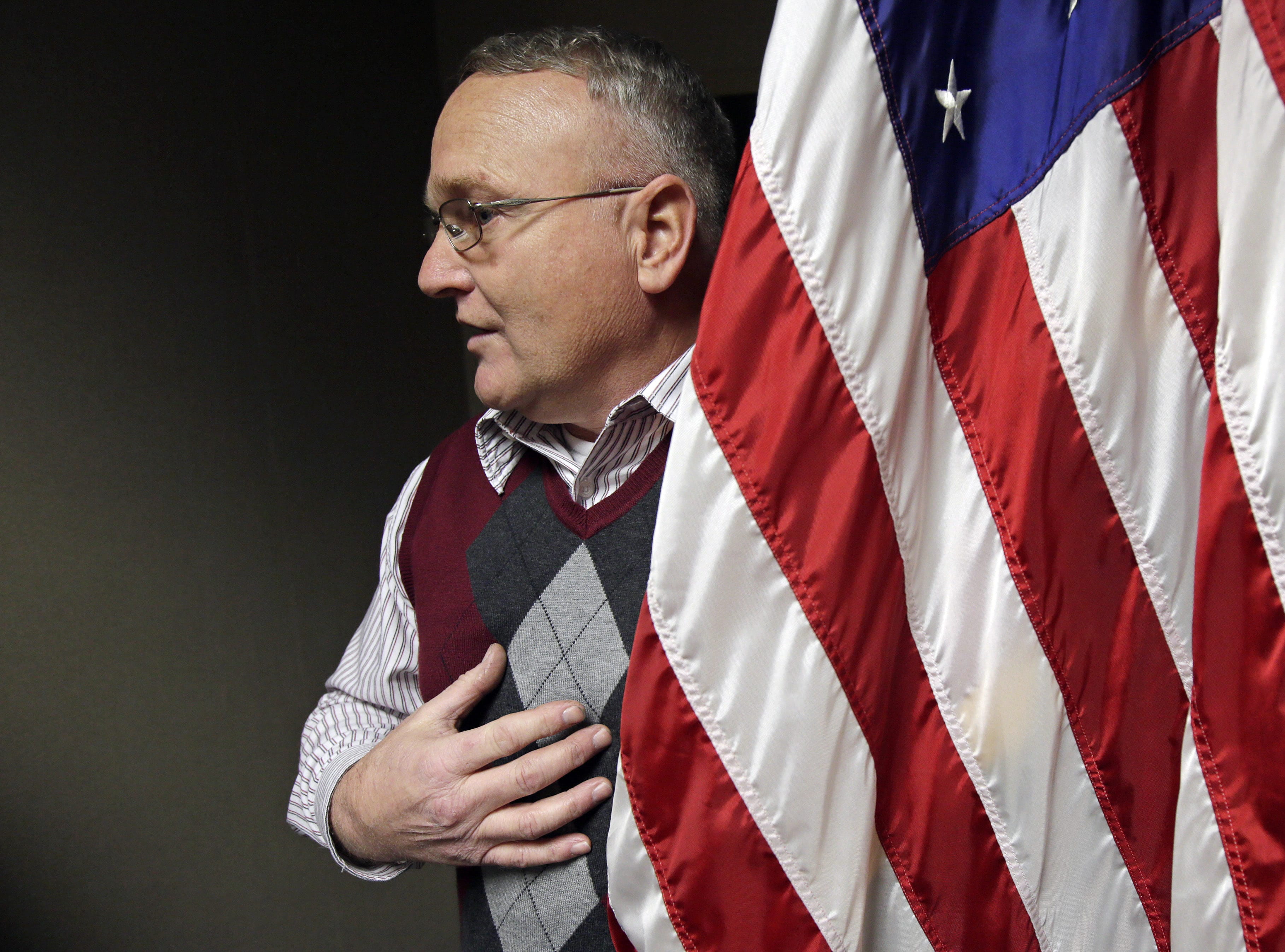Are burn pits a possible answer for the mysterious ailments reported by veterans?
 U.S. Army veteran Brandon Garrison, right, talks with his father, Stephen Traglio, who also served in the Army. Garrison served in Afghanistan and now has several health conditions that he says may be linked to the burn pits used to dispose of waste at U.S. military bases there.
(Photo: Andy Marso / KHI News Service)
U.S. Army veteran Brandon Garrison, right, talks with his father, Stephen Traglio, who also served in the Army. Garrison served in Afghanistan and now has several health conditions that he says may be linked to the burn pits used to dispose of waste at U.S. military bases there.
(Photo: Andy Marso / KHI News Service)
Published December 31st, 2014 at 12:32 PM
Four months ago, U.S. Army veteran Brandon Garrison played in an all-day softball tournament, a fundraiser for the Wounded Warrior Project.
“The tournament was on a Saturday,” Garrison said. “The next day I woke up and I couldn’t walk.”
Garrison, a 28-year-old from Leavenworth, experienced debilitating muscle pain for several days and was hospitalized at a U.S. Department of Veterans Affairs facility. He left with a cane that he was still using last month.
After multiple wartime deployments to Afghanistan as an infantryman and a supply specialist, Garrison has health conditions that are explainable: traumatic brain injury from the concussive blasts of explosives and post-traumatic stress disorder from the strain of combat. But he also has conditions that are harder to explain: nerve twitches, muscle weakness, fibromyalgia, chronic prostatitis, low testosterone.
In researching those symptoms in U.S. soldiers, he came across websites like Burn Pits 360, where other veterans discussed the potential hazards associated with the massive open air burn pits used to dispose of waste at U.S. military bases in Iraq and Afghanistan. Garrison used those pits in his supply role. He remembered some of the things that were thrown into them: feces, human remains, the carcasses of diseased animals, batteries, spent ammunition casings, medical waste.
“We were taking used vehicle parts that had transmission fluid, hydraulic fluid, things like that and throwing them in these burn pits,” he said. “My job was to turn this stuff in. If it’s unserviceable, we disposed of it. Tires. Paint, I’m sure. Any one of those things, if you burn it stateside, you can get written up for it because it’s a hazard.”
At the time, he didn’t think about it. He was worried about other things. But now he wonders what he might have inhaled, and how much of it.
“I was making multiple trips to these burn pits a day,” Garrison said. “Multiple.”
Great unknowns
Many veterans of the Iraq and Afghanistan conflicts believe their health was affected by exposure to the burn pits and other potential environmental hazards. But there is not enough data to determine whether that exposure caused or contributed to the health problems they are struggling with now that they are home.
It took decades for the military to assess the health damage done by Agent Orange, a mix of chemicals used to defoliate the jungles of Vietnam and Korea while American troops were fighting in those countries.
Garrison fears the burn pits could be “the Agent Orange of our generation.”
The U.S. Department of Defense says there is not enough information on burn pit exposures to draw definitive conclusions about their health effects, and it continues to study the issue.
The VA website states that “at this time research does not show evidence of long-term health problems” associated with burn pit exposure. That preliminary conclusion is based on a 2011 National Institute of Medicine report that stated researchers did not have enough data to determine whether there were any long-term effects.
So, the research continues.
A Vanderbilt University researcher studying returning veterans at Fort Campbell who complained of shortness of breath found that the chronic lung disease constrictive bronchiolitis was widespread among those studied and “was possibly associated with inhalational exposure.”
More studies on “deployment related lung disease” are under way at National Jewish Health in Denver, which bills itself as the nation’s top respiratory hospital.
Some veterans are not waiting for the results of further study.
A group of them filed a class action lawsuit against Kellogg, Brown & Root, the military contractor responsible for waste disposal efforts overseas. Other attorneys are pushing for claims from soldiers who served at a long list of sites where burn pits were used.
Last year Congress and President Barack Obama approved a law establishing a burn pit registry where veterans can sign up to track changes in their health and get research updates.
Difficult to diagnose
Robert Miller, a pulmonary specialist at Vanderbilt’s medical school, started getting calls from Fort Campbell-area health care providers in 2004. Thousands of Army troops were returning from their first deployments overseas and dozens were reporting shortness of breath while exercising.
Flummoxed doctors referred the soldiers to Miller. Initial pulmonary tests and X-rays were normal. But something was wrong. Men and women who were in excellent physical condition when they deployed were struggling to run two miles when they returned.
“That was the picture that we were seeing,” Miller said in a phone interview. “So we started doing lung biopsies on them.”
Of the 49 biopsies, nearly all showed abnormalities, and 38 of the 49 showed constrictive bronchiolitis, a scarring of the small airways in the lungs that impairs function when lungs are strained.
“It’s essentially (like) trying to breathe through a straw when you’re running,” Miller said.
About three-fourths of the initial group of soldiers biopsied had been exposed to a significant sulfur mine fire while in Iraq. That initially was identified as a possible cause of the lung distress.
But as Miller and his colleagues continued with the biopsies, they found that the “vast majority” continued to show signs of constrictive bronchiolitis, even as the share of those exposed to the sulfur fire dropped below 50 percent.
The test results, Miller said, indicated the lung condition was somehow connected to the soldiers’ deployment to Iraq but not necessarily to exposure to the fumes produced by burn pit fires.
“We don’t know the exact source for their exposure. We just know … the things associated with deployment, so we make a list,” Miller said. “On that list are dust storms, particulate matter and burn pits, diesel fumes, battlefield smoke, all those things. Although I’m very concerned about the burn pits, we have never made a claim that is the cause. We make a very strong claim these diseases are associated with deployments.”
That itself was significant.
Miller said constrictive bronchiolitis usually is found in patients with rheumatoid arthritis of the lungs or in organ recipients who reject a transplanted heart or lungs. It’s also been documented in people with “toxic exposures” who inhaled things like nerve agents or dust from popcorn flavoring in food processing plants.
“It’s not something that occurs randomly,” Miller said. “That’s the key thing. You don’t find constrictive bronchiolitis in unexposed, otherwise healthy young adults. You just don’t.”
Yet that was the age group in which Miller and his team were seeing it, and other physicians began seeing it too.
“I think I stumbled upon the sentinel case, at least here (in Kansas),” said Michael Crosser, a pulmonologist at the University of Kansas Hospital.
Late in 2008, a soldier who returned from a deployment in Iraq and had been treated at Munson Army Health Center in Leavenworth for complaints of shortness of breath while exercising was referred to Crosser.
The man was a nonsmoker, and there was a clear change in his exercise capacity since his deployment. But just as with Miller’s soldiers, the initial tests were clear.
Then Crosser saw Miller’s research published in the New England Journal of Medicine. He tried to convince a surgeon to do a biopsy of his patient’s lung.
“For most surgeons, they’ll say, ‘You want me to biopsy what and why? He’s got normal functions, his CAT scan’s normal,’” he said.
Crosser forwarded Miller’s abstract to the surgeon and pressed his case.
“I said, ‘I’ve got a believable patient who is symptomatic, who has been exposed and I think he has this condition. This is what I’m looking for,’” he said. “And that’s certainly what I found.”
Miller said stories like that are common.
“I have inquiries from all around the country,” he said.
Both Miller and Crosser have ceased doing lung biopsies on veterans with suspected constrictive bronchiolitis, because it’s an invasive, painful procedure with risk of complications, and even if the disease is definitively diagnosed, there are no proven treatment options. All doctors can do is recommend that their patients avoid further exposure to whatever caused the condition.
Having the diagnosis can help veterans procure disability benefits. But even with a diagnosis, some struggle to obtain benefits, Miller said.
“It has been a very difficult process, which is part of the reason I started advocating for these guys,” Miller said. “I’ve seen them, I know they’re limited and I know there’s a link between that limitation and deployment.”
‘I’ve been there’
Garrison, the Army veteran from Leavenworth, qualified for disability benefits because of other conditions that have made resuming civilian life difficult.
When he first returned in 2007, he tried to get behavioral health services, but the wait was long because of the influx of other soldiers trying to do the same. So he decided to see a primary care doctor, who prescribed Valium.
“So I started popping those,” Garrison said.
Soon after, he said, the combination of a bucket of Bud Lights and “three or four Valiums” in one day landed him in a private hospital, where he woke up with a Vietnam veteran standing over him.
“He looks at me, and he says, ‘I know where you’re at brother; I’ve been there. And if you allow me to help you, I’ll take you upstairs. I know some people who can do some good,’” Garrison said.
That was the beginning of a two-month stay at an inpatient psychiatric ward, followed by four more months at Walter Reed Army Medical Center, where he was treated for PTSD and traumatic brain injury.
From there he returned to the Kansas City area, where he had the support of family, friends and former Leavenworth-area Kansas legislators Candy Ruff and Melanie Meier.
“Those two ladies have been in my corner since day one,” Garrison said. “They’re amazing people.”
Still, Garrison struggled in his post-military transition.
He was a good student before he enlisted, but when he tried to go back to school after the war he found that the college coursework didn’t seem relevant to his life, and he had trouble concentrating. He argued with his parents and his wife, fights he now acknowledges were mostly his fault.
“Most of the time it was because of stupid things I was saying or doing,” Garrison said. “The way I reacted to things, the way I saw things. I was a totally different person when I got back.”
Garrison and his wife tried to move to an Operation Homefront village in San Antonio that provided free housing for veterans. But their marriage was falling apart and she left.
“Actually, I told her to leave me,” Garrison said. “Biggest mistake of my life.”
He made another attempt at school, enrolling at Schreiner University in Kerrville, Texas, and took pride in making the baseball team at the small college.
But that was when the chronic muscle aches started. Then one day he collapsed on the field.
“Ended up in a VA hospital,” Garrison said. “They just told me that ‘maybe you were dehydrated.’”
He was given fluids for several days and felt better, but there were other warning signs. He had widespread bruising, and testing revealed his levels of CPK, an enzyme that leaks into the bloodstream when muscles are damaged, were “extremely elevated.”
High CPK levels also can be indicative of brain injury. Garrison was still fighting the effects of his traumatic brain injury and PTSD as he stayed alone in his loft apartment.
“I would fall asleep pointing my weapon because I was convinced somebody was going to come up that damn stairway,” he said. “Living alone is not good for me.”
He moved back home with his parents in Leavenworth and, after several unfulfilling jobs, found one that seemed to stick: working for the Federal Bureau of Prisons.
“I was needed in an environment like that,” Garrison said. “You respond to calls, you’re back in the action. I got along with inmates and other guards better than (with co-workers) in any previous job.”
Then came August, the Wounded Warrior softball fundraiser and the return of the muscle pain.
That pain has not been definitively connected to burn pit exposures, but something Garrison’s urologist told him recently again made him think of the pit fumes he inhaled.
“She told me, quote, ‘I believe you were exposed to a neurotoxin or neuroagent,’” Garrison said. “She proceeded to tell me that she has seen several veterans my age and younger who have been diagnosed with this same thing I was diagnosed with two weeks ago: chronic prostatitis.”
Soldiers deployed to Iraq and Afghanistan were exposed to other things, like the 2003 sulfur mine fire, chlorine gas attacks, titanium dust and abandoned, long-dormant chemical weapons.
And burn pits have been used on military bases for decades. Garrison’s father, who is now battling brain cancer, remembers using one when he was deployed to Ethiopia.
But Garrison wonders if there ever have been pits as big as the one he used at Bagram Airfield, which he estimated was between five and 10 acres long. The fumes from that pit have been a subject of study by the U.S. Army.
“It’s hovering over the entire base, so anybody who’s outside is breathing this in,” Garrison said. “Even the little computer guy who goes to and from Pizza Hut every day. Nobody was free of these exposures.”
Andy Marso is a reporter for KHI News Service in Topeka, a partner in the Heartland Health Monitor team.



